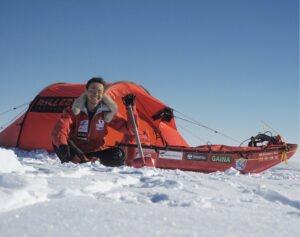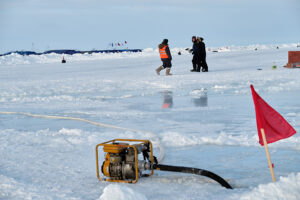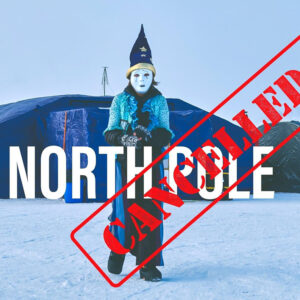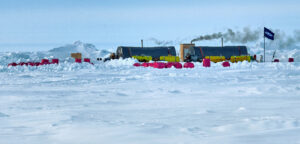In 1958, President Eisenhower ordered a U.S. Navy mission of such secrecy that most of the crew were not aware what it was until after departure. If the mission succeeded, it promised to be a globally celebrated, historic event.
Known as Operation Sunshine, a crew of 116 men and their 37-year-old captain, Commander William R. Anderson, boarded the nuclear submarine USS Nautilus to travel where no one had been before: under the Arctic Ocean to the North Pole.

The commander inspects the crew of the USS Nautilus. Photo: Courtesy of weaponsandwarfare.com
Today, such a mission hardly seems remarkable, but take yourself back to the era. The environment was unpredictable, the technology lacking.
One major technological issue for North Pole expeditions was that magnetic compasses become erratic near the North Pole. Gyrocompasses, which use the Earth’s spin to find true north, also malfunction due to the changing rate of spin at the Pole. This issue almost proved fatal on one of Commander Anderson’s earlier expeditions, in 1957.
That year, Anderson led the Nautilus under the Arctic ice from the Atlantic. His objective was exploratory: He was tasked to gather valuable readings that could serve for future, larger missions. But shortly after submerging, Anderson ran into trouble.
In his book, The Ice Diaries: The True Story of One of Mankind’s Greatest Adventures, Anderson wrote, “Essentially, we were entering an unexplored cave 2,000 miles deep. There were no profiles to go by, no maps of either the ice overhead or the ocean floor below.”

Commander William R. Anderson and his family after the Nautilus’s success. He led on Operation Sunshine at just 37 years old. Photo: Courtesy of watchthismagazine.com
A malfunction in the gyrocompass prompted Anderson to give the order to ascend. He realized too late that there was ice above, in an area he had thought to be clear. Ice collided the vessel with a frightening shudder and thunderous noise. The crew narrowly escaped unharmed, and the mission was aborted.
For his 1958 mission, Anderson was not willing to take further risks and flew over the Arctic by plane beforehand. Armed with false identification papers — such was the nature of the secrecy during the height of the Cold War — Anderson first flew from Seattle to Alaska to study the route, before Operation Sunshine’s launch in the upcoming weeks.
From the air, he and a colleague noted areas in the ice cover where floes had collided, buckling the skin of the ice into high ridges. Such ridges likely also extended below the surface, where they could prove hazardous for a submarine and its crew.
Anderson was well-chosen for pioneering a submarine expedition to the North Pole. He graduated from the United States Naval Academy in 1942. Shortly after, he was assigned to submarine school in Groton, and later served on combat missions in the Pacific in World War II, before heading Groton’s submarine school in the post-war years.He was known to be hard-working and quiet, leading by example.
But Anderson was not the only hero of this expedition.

The USS Nautilus was the 571st submarine built by the US Navy, and the world’s first nuclear-powered submarine.
The Nautilus was the world’s first nuclear-powered submarine. As such, it was able to overcome challenges previously encountered on undersea arctic expeditions.
The reactor produced steam that drove propulsion turbines, allowing Nautilus to reach speeds in excess of 20 knots. It could dive deeper and go faster than conventional submarines.
For the crew, nuclear power also meant more creature comforts. They could read by light and enjoy cold Coke, and the interior was a consistently warm 72˚F.

USS Nautilus exceeded speed records and also boasted a luxurious living standard for the onboard crew.
Previous models were also known to be small inside. Crew members would typically share bunks: While one crew member was on duty, the other would rest. The Nautilus offered a spacious mess hall and a separate bunk for each person.
Nuclear power also let the crew desalinate and purify water faster than before, so they could shower and wash daily. Although we might still find it cramped, for submarine personnel, the Nautilus was a four-star hotel under the freezing Arctic Ocean.
Importantly, the nuclear reactor ensured that the Nautilus did not have to surface for air. Carbon dioxide scrubbers and carbon monoxide burners purged the air of unwanted gases, allowing long periods of submersion. Diesel-powered models were only able to dive for short periods of time.
Crucially for an expedition to the North Pole, a special gyrocompass was installed just before the journey began.
On April 25, the Nautilus left New London, Connecticut and arrived at Pearl Harbour on June 28. Here, the Nautilus and its crew waited for 25 days, until summer had advanced enough for the skin of ice on the Arctic Ocean to thin out and many patches of open water to form. It was only at Pearl Harbour that Anderson informed the crew of their secret mission.
Because of the dangers involved, crew members were offered an opportunity to disembark at Pearl Harbour. Not one left the ship, and on July 23, 1958, the Nautilus left the balmy waters of Pearl Harbour for the North Pole.
On August 3, the Nautilus became the first vessel to reach the geographic North Pole. Eventually resurfacing northeast of Greenland, they had spent 96 hours under the ice, submerging 2,000 feet deeper than anticipated. They had made history.






